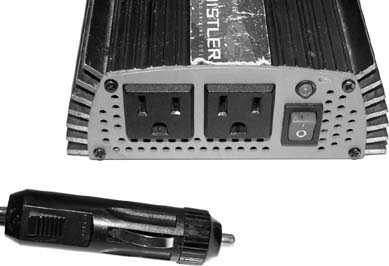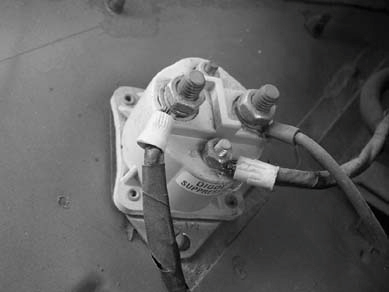Hack11.Put Home Power Outlets in Your Car
Hack 11. Put Home Power Outlets in Your Car
If you need to power a device that doesn't come with a car adapter, or if you want to run a top-of-the-line PC that consumes 300 watts, you will need to use a device called an inverter to convert your vehicle's 12V to the 120V or 220V found indoors. "Understand Car Electrical Systems" [Hack #1] showed how you can convert the high-voltage power from a wall outlet into the 12V and other voltages needed by computers. If you need to power an in-home device in the car, however, the reverse can be done, using a device called an inverter. 1.12.1. What Inverters DoAmerican household voltages have been standardized at around 120V, and power in Europe generally runs at 220V. While vehicles and batteries use something called direct current, indoor voltages are alternating current. Direct current (DC) is simple: 12V on one wire, 0V on the other, and the current goes around in a loop from the 12V wire through the device and back to the 0V ground wire. Alternating current (AC) has a wavy pattern: the main two wires in AC trade off being at ±60V (in North America), back and forth, 60 times per second. (In Europe, the voltage waves ±110V, 50 times per second). The third "ground" wire in AC voltage usually connects to a metal pole sticking into the ground, and it actually acts as a failsafe return path for current if there should be a power surge, short circuit, or lightning strike. So, inverters have to do two things: they have to increase the 12V 10 to 20 times, and then they have to convert the simple DC voltage to the more complex back-and-forth AC current. Inverters use a certain amount of the power coming into them just to convert the voltageabout 20% of the wattage is lost in translation. Thus, if your computer needs 100W to run, the inverter will draw 125W from the battery/alternator in order to supply it. In practice, you should probably have an inverter rated for twice what your devices demand. In my experience, when you first turn on devices (such as computers or power supplies for laptops) they create a big power surge, which can flip the circuit breaker built into your inverter. Then, even though the device settles down to its rated power draw, well within the inverter's rating, the inverter will have freaked out and shut down everything. The only caveat is that too powerful an inverter will waste power (on fans and heat) and give you less running time when the car is offbut you shouldn't be using an inverter if you're trying to maximize battery time. 1.12.2. Choosing an InverterInverters come in various sizes and generally look like heat sinks, as you can see in Figure 1-20. They are usually packaged in colored aluminum and have a 12V plug on one side and several outlets on the other side. They often include an easy-to-replace fuse on the outside. The key to comparing inverters is their wattage, because each inverter is designed to power devices only up to a given wattage. (I discussed how to convert amps to watts in "Calculate Your Car's Battery Life" [Hack #5].) A small inverter might be able to handle 50W, or just over 4A (50W / 12V). That means it could power a few cell phone chargers, or perhaps a laptop power converter. Larger inverters might be rated for 200W, 300W, 500W, or even 1200W. The higher the wattage rating is, the more likely it is that the unit can supply power for hungry devices such as dual-processor computers, 21" flat-screen monitors, or power tools. Figure 1-20. An inverter If you are using a smaller inverter, you are likely to quickly exceed its power, so you have to make sure you overcompensate. Also bear in mind that almost all devices have a current spike when they are first turned on or plugged in, so if you are using a small inverter at its wattage limit, you may need to power on your devices one at a time so as not to trip the circuit breaker or fuse built into the inverter. 1.12.3. Powering High-Amperage InvertersBeware of having eyes bigger than your socketswhen you see a power outlet in your car, it's very tempting to start hooking up power strips and extension cords and treating it just like wall power, but most wall outlets can easily supply thousands of watts, whereas only the biggest inverters come close to that. If your vehicle is off and you don't have a dual-battery system [Hack #10], you're probably not going to be able to start your car for long if you use a huge inverter. Sustaining 1200W requires 1200W / 12V = 100A. As discussed in the previous hack, conventional batteries might be able to put out 25A for 2 hours, but a 100A draw is like cranking your car to start itsomething batteries are designed to do for only about 30 seconds. If you're running a huge inverter without a huge secondary battery, you're going to need to leave the engine idling while you run your devices. This car-as-generator approach is the same one taken by bigger work trucks and pickups. When they need to power high-voltage AC power tools, they have an inverter professionally installed in the truck and have power outlets right on the back of the vehicle. In RVs there are power outlets as well, and these run off either the power of the engine, a bank of batteries charged by the engine, or a separate, more efficient generator that runs off the gas (or even another fuel, such as propane or diesel). 1.12.4. The Hack: Wall Outlets in Your CarIf you really want to do a high-quality installation of power outlets, make sure that all your power supply issues are taken care of: that you have a strong enough battery to power these outlets for a while (or a secondary battery that can be completely discharged), or that you power the outlets only when the car is on. If you have a very strong inverter but only a single battery, you probably want to make sure the inverter only powers on with the engine. First, to make sure that you won't drain your battery while driving, read "Upgrade Your Car's Alternator" [Hack #9]. Then, because you need to run a thick cable to supply 100W or more to the inverter, read "Gauge Your Wires" [Hack #3]. If you need a very high-current switched output (so that the inverter is on only when the car is on), you are going to need to use another device to turn the current on or off. The reason is that the switched wires that run from the accessory or on positions of the ignition are not going to be thick 4-gauge or 2-gauge wires. Thus, you are going to need to use a device called a starter relay (see Figure 1-21) to activate the 100A current on the power wires when the thin accessory wire goes on. The automotive relay is a simple switch. It has four terminals (wire posts): IN, OUT, 12V, and ground. You can even see from the size of the terminals which posts activate the switch and which posts carry the heavy relay current. You can mount the relay in the trunk or the front of the vehicle; it's probably easier to mount it in the trunk if that's where you're mounting the inverter. Because other devices (such as amplifiers) will want access to the unswitched high-amperage 12V, you should supply them first and then route the power into this relay, and then to your inverter. At this point, your inverter will turn on when the car key is in the accessory position or when the vehicle is on. If you want to make sure that it is on only when the engine is actually on, you will need to consult your vehicle's manual or an installer, who can find a switched 12V connection that's on only when the car is on. Figure 1-21. A starter relay Using a power strip is possible with a high-output inverter, and thickly insulated extension cords are pretty safe as long as you don't run them underneath the carpets or hide them in such a way that they might short out on the metal of the vehicle. If you want the electrical outlets cleanly exposed for easy access or prominent display, your best solution is to install the inverter right behind the panel where you want the outlets. With this setup, you aren't snaking these higher-voltage 120V wires dangerously around your vehicle. 1.12.5. Hacking High Voltages SafelyYou may not have known this, but 12V of DC power is not likely to shock you. You can test this by touching the poles of your battery, one with each hand. You most likely won't get a shock; if your hands are wet you might feel a tingle. Wall outlet high-voltage AC is another thing altogether. Do the same trick with AC, and your body will jerk back and you'll hurt for a while. You might get a small heart attack, or you might get "frozen" onto the wires and not be able to let go.
The goal of this hack is to install actual power outlets in the walls of your car, just like those in your house. However, realize that you're now dealing with high AC wall voltage. You do not want to run high-voltage AC wiring any distance in a car. Besides being very unsafe, it may not be legal unless installed by a licensed electrician (who may laugh at you when asked to install it). The best solution is to safely mount the inverter so that its power outlets are flush mounted with the walls of the vehicle. Running 12V wires around the car is pretty harmless, because if the wires short circuit they will ultimately just blow a fuse. However, the high-voltage output from the inverter is the same voltage you have in your house, and just as you wouldn't run extension cords under the carpet in your home, you shouldn't do this in a vehicle. If you really want to put a wall outlet inside your vehicle, make sure that the power is run safely, according to the electrical codes and regulations that RVs must comply to. You can look at a copy of the National Electrical Code (NFPA 70) at a technical library or buy NFPA 70 at http://webstore.ansi.org.
One additional but less threatening aspect of AC current is that it can create interference with audio systems. Take care to keep high-voltage AC lines shielded and apart from audio cables to reduce interference. FM reception can be degraded while using an inverter because of the interference, so if your radio starts getting bad reception, your recently installed inverter may be the culprit. |
